A powerful earthquake measuring 8.8 struck off the coast of Russia’s Far Eastern Kamchatka region on Wednesday, triggering tsunami warnings across Japan and the US state of Hawaii.
The tremor destroyed buildings and left many people injured. Authorities in large parts of Japan and parts of Hawaii issued evacuation orders.
ALSO READ | Why Russia earthquake set off tsunami alerts across US
More than 50 aftershocks took place after the main quake. Seismologists have warned that further tremors, possibly reaching a magnitude of 7.5, could still occur in the coming days or weeks.
Visuals posted on social media showed sections of an airport’s ceiling collapsing during the quake.
In this explainer, we look at the impact of the earthquake in the Kamchatka region.
Let’s take a look:
Russian earthquake: The damage caused in Kamchatka region
The powerful earthquake, one of the strongest ever recorded globally, struck at 8:24 am local time off the coast of Petropavlovsk-Kamchatsky.
Despite the strength of the quake and tsunami, the reported damage in the region was limited.
A local port was flooded, and parts of the ceiling at a regional airport terminal fell, according to The New York Times. Authorities confirmed that evacuations had gone ahead successfully.
Yaroslav, 25, a resident of Kamchatka, told Reuters, “It felt like the walls could collapse any moment. The shaking lasted continuously for at least three minutes.”
Tsunami waves partially flooded the port and a fish processing plant in the region, dislodging vessels from their moorings, according to regional officials and Russia’s emergency ministry.
Impact Shorts
More ShortsVerified drone footage showed the shoreline submerged, with taller buildings and storage units surrounded by water, Reuters reported.
Later, the Klyuchevskoy volcano on the Kamchatka Peninsula began erupting, according to a geological monitoring agency. The volcano, located around 450 kilometres north of Petropavlovsk-Kamchatsky, is among the highest in the world.
More than 50 aftershocks followed the main quake, and seismologists have warned that tremors reaching magnitude 7.5 could still happen in the coming days or weeks, The Moscow Times reported.
Petropavlovsk-Kamchatsky Mayor Yevgeny Belyaev said public services were on alert and inspections for damage were ongoing. So far, most of the impact appeared cosmetic, though elevator outages were reported in some new apartment buildings.
Local media said several national park zones had been closed to tourists due to the risk of landslides and falling rocks.
At Yelizovo Airport in Petropavlovsk-Kamchatsky, all flights were delayed until Thursday.
Videos posted online showed parts of the interior ceiling falling during the quake, while passengers were seen rushing to safety. Some travellers reported struggling to reach emergency exits, The Moscow Times reported.
In neighbouring Sakhalin, authorities began recovery work in Severo-Kurilsk on Paramushir Island, part of the Kuril Islands, which was badly hit by the tsunami flooding.
The full scale of the damage remains uncertain, and the local governor said a detailed assessment would take about a week.
ALSO READ | What caused 8.8 earthquake in Russia’s Kamchatka?
Why was the damage not as destructive as previous tsunami?
In deep ocean waters, tsunami waves can move at speeds over 500 miles per hour (800 kilometres per hour), roughly the pace of a passenger aircraft.
Out at sea, these waves have long gaps between them and are usually no more than a metre high, making them hard to detect.
However, as they approach shallow coastal areas, the waves slow down, often to just 20 to 30 miles per hour. At this stage, their height can rise sharply.
Authorities said Wednesday’s earthquake triggered waves as high as four metres (13 feet) in some parts of eastern Russia.
The US Geological Survey initially reported that the earthquake struck at a relatively shallow depth of about 20.7 kilometres (12.9 miles) beneath the surface.
Shallow quakes like this often cause more movement of the seafloor, which can generate larger tsunami waves. Still, it is difficult to know the full impact so soon after the quake.
Despite the strength of this earthquake and tsunami, the damage was less severe than in some past disasters. Factors such as the wave direction, local geography, and immediate evacuations may have helped reduce the impact this time, BBC reported.
‘God help me’: Residents recount massive Kamchatka earthquake
A state of emergency was declared in Petropavlovsk-Kamchatsky after the powerful earthquake struck the region.
Residents of the city, located 149 kilometres from the epicentre, described scenes of chaos: buildings swayed, furniture toppled, cars appeared to “dance” in the streets, and even cranes at the harbour were seen shaking.
A Kamchatka native with family in the area told The Moscow Times, “Everything’s fine, but everyone is absolutely freaked out. It was the strongest earthquake in decades.”
He said his relatives had decided to leave the city for their dacha, adding that many others seemed to be doing the same.
Several Kamchatka residents turned to social media to describe what they had experienced.
One user wrote, “I have been living in Kamchatka for 42 years, but it was the first time I felt such an earthquake. I screamed so much: ‘God help me,’ although I am generally calm during earthquakes. Everything at home was smashed.”
The report also pointed to a rise in resort prices, as some businesses appeared to take advantage of people seeking safety.
According to the local edition of Argumenti i Fakti, emergency services in the city saw a spike in calls after the quake. Many residents reported symptoms like high blood pressure, arrhythmia and seizures.
With inputs from agencies


)

)
)
)
)
)
)
)
)



